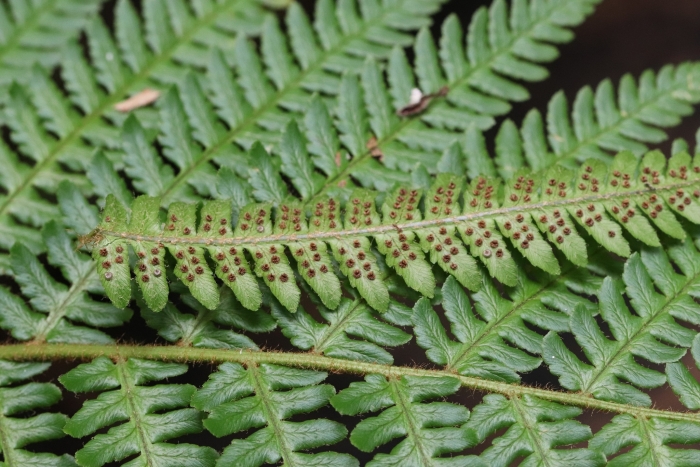Thick-Stemmed Wood Fern
(Dryopteris crassirhizoma)
Thick-Stemmed Wood Fern (Dryopteris crassirhizoma)
/
/

Nina Filippova
CC BY 4.0
Image By:
Nina Filippova
Recorded By:
Copyright:
CC BY 4.0
Copyright Notice:
Photo by: Nina Filippova | License Type: CC BY 4.0 | License URL: http://creativecommons.org/licenses/by/4.0/ | Rights Holder: Nina Filippova | Publisher: iNaturalist | Date Created: 2021-08-25T12:25:55-07:00 |

























Estimated Native Range
Summary
Dryopteris crassirhizoma, commonly known as Thick-stemmed Wood Fern, is a semi-evergreen fern that can reach up to 3 feet in height and width. It is native to East Asia, including Japan, Korea, and northeastern China, where it thrives in moist, shaded forest understories and on forest margins. This species is characterized by its vase-like clump of arching, narrowly-divided fronds that emerge from a central, scaly, brown crown. The fronds are deep green and have a leathery texture, contributing to the plant’s lush appearance throughout the growing season and into winter in milder climates.
Thick-stemmed Wood Fern is valued for its robust form and the textural contrast it provides in shaded garden settings. It has earned the Royal Horticultural Society’s Award of Garden Merit, indicating its exceptional performance in cultivation. This fern is often used in woodland gardens, shade gardens, and as an understory plant in shaded borders. It prefers consistently moist, well-drained soils rich in organic matter and thrives in part to full shade. While it is generally low maintenance, it is important to ensure that the soil does not dry out. This fern is not known for serious pest or disease problems, but it can suffer from root rot if the soil is too wet. It is also recognized for its antibacterial properties and is used in traditional medicine for its medicinal constituents.CC BY-SA 4.0
Thick-stemmed Wood Fern is valued for its robust form and the textural contrast it provides in shaded garden settings. It has earned the Royal Horticultural Society’s Award of Garden Merit, indicating its exceptional performance in cultivation. This fern is often used in woodland gardens, shade gardens, and as an understory plant in shaded borders. It prefers consistently moist, well-drained soils rich in organic matter and thrives in part to full shade. While it is generally low maintenance, it is important to ensure that the soil does not dry out. This fern is not known for serious pest or disease problems, but it can suffer from root rot if the soil is too wet. It is also recognized for its antibacterial properties and is used in traditional medicine for its medicinal constituents.CC BY-SA 4.0
Plant Description
- Plant Type: Fern
- Height: 2-3 feet
- Width: 2-3 feet
- Growth Rate: Slow
- Flower Color: N/A
- Flowering Season: Non-Flowering
- Leaf Retention: Deciduous, Semi-deciduous
Growth Requirements
- Sun: Part Shade, Full Shade
- Water: Low, Medium
- Drainage: Medium
Common Uses
Border Plant, Low Maintenance, Potted Plant, Rabbit Resistant
Natural Habitat
Native to moist, shaded forest understories and forest margins in East Asia
Other Names
Common Names: Crown Wood Fern, Asian Wood Fern
Scientific Names: , Dryopteris crassirhizoma, Aspidium filix-mas var. maackii, Dryopteris buschiana, Dryopteris buschiana var. maackii, Dryopteris crassirhizoma var. crassirhizoma, Dryopteris crassirhizoma var. maackii, Dryopteris setosa,
GBIF Accepted Name: